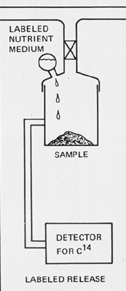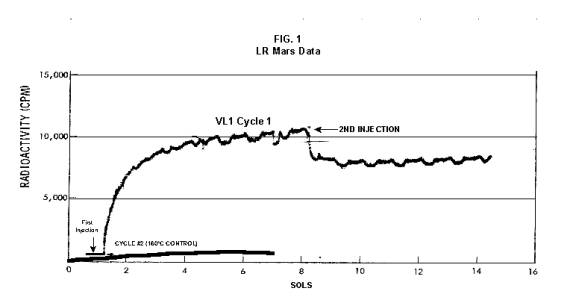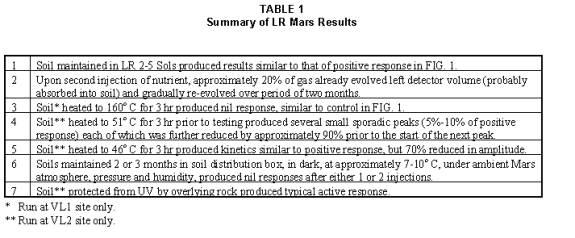Introduction
Definition of Life
Motivation
Preliminary
Steps
Present Life
Past Life
Geological Survey
Sample Collection
Spectroscopic Analysis
Organic Analysis
Biology Experiments
Thin Section
Isotope Analysis
Experimental Design
Labeled Release Experiments
Brief Synopsis
The labeled release experiment (LR), on the Viking mission, was
based on the assumption that any extant life on Mars would metabolize
simple carbon compounds and produce gaseous wastes.
Therefore, the experiment called for the incubation of a sample
with a low concentration nutrient of radioactively marked carbon molecules
and the subsequent testing for gaseous products containing the radioactive
elements. This experiment
produced a great controversy, as its results were inconclusive as to
whether or not life existed on Mars.
However, the assumptions made and the obstacles discovered for this
experiment can be averted by being more conservative in identifying
possible samples.
Equipment
- Viking composite instrument including 14C detector
- Nutrient: aqueous solution of 2.5 x 10-4 molar concentrations each of formate, glycine, D-alanine, L-alanine, D-lactate, L-lactate, and glycolate, each labeled with 14C as opposed to 12C
- source of helium gas to ensure the liquidity of the water in the nutrient solution
- heat source

Protocol
n place .5 cc sample in the sample chamber
n add .155 mL of the nutrient to the sample
n add enough He gas just to overpressurize the chamber
n incubate the sample at 10°C to ensure minimal premature evaporation of liquid
n monitor the gas evolution over a period of 8 days
The gas evolution is monitored by an attached 14C detector which detects gases containing 14C. The existence of such gases indicates that the soil sample had metabolized the nutrient compounds to gaseous products. The control of the experiment goes as follows:
n heat the sample at 160°C for 3 days
n repeat the above procedure
If there is a gas present after this heating, the reaction products are from a chemical reaction and not a biological reaction as chemical reactions can be sustained at higher temperatures. However, if there is no gas present, it is assumed that whatever organism that metabolized the nutrient was killed under the drastic change to the environment and that the gaseous products viewed beforehand were the products of a biological reaction.
Viking results
The graph below indicate the results for one experiment. The table below summarizes all the experiments.


An analysis of the trends in the results are as follows:
1) There appeared a uniform production of gas issues when the nutrient was placed on Martian soil.
2) The reactant in the Mars soil is completely inhibited by heating the soil to 160°C
Therefore, one would suggest that this experiment did indeed find life on Mars. However, many discrepancies were detected between the experiment and other known facts of Mars and the assumptions the experiment was based on.
Problems
The following are the arguments against the validity of the results of the labeled release experiment brought forth by many experts and compiled by Gilbert Levin, the designer of the LR experiment:
-
No organic compounds were found in Martian soil analyzed by the Viking Gas Chromatograph Mass Spectrometer (GCMS).
-
H2O2 , chemically formed in the upper atmosphere, was thought to descend to the soil and, directly or through forming complexes or compounds, to oxidize the LR substrates to evolve labeled gas. For example, the reaction of formic acid (present in nutrient) and hydrogen peroxide (H2O2) produces water and carbon dioxide which would be detected as radioactive.
-
It was assumed that there is no liquid water on Mars, and that its absence would make life impossible; and, as a corollary, the overall environment was believed too extreme to support life.
-
The amplitude and kinetics of the LR response from Mars was thought to be "too much too soon" for any putative Martian biology.
-
Although not a pre-mission criterion for life, a second injection of LR nutrient onto positive samples failed to re-invigorate the evolution of gas, as generally occurs with terrestrial soils. Instead, some of the gas evolved after the first injection appeared to be reabsorbed into the soil.
-
No visual evidence for life was reported when the Viking camera images were examined.
-
UV light from the sun was thought to activate soil particles, which then disrupted the LR nutrient upon contact, releasing labeled gas. Also, UV light's destructive effect was held to account for the reported lack of any organic matter on Mars.
-
Clays on Mars were proposed to react with the LR nutrient to release labeled gas.
Alterations made to protocol
The best way to obliterate these questions is to be more conservative in our choice of samples. First of all, we will only test samples that have previously been tested by a GC/MS for the presence of carbon compounds or any other organic compounds. Secondly, we will choose a sample at a site that is relatively protected from harmful UV rays, is relatively warm, has little or no concentration of peroxides or superoxides, and has tested positive for water. This type of sample will most likely be found underground and will be obtained by the use of a drill. Any type of clay detected on Mars should be tested as a control to ensure that there are no false positives. Furthermore, the argument that no life was seen by the Viking cameras is rather inaccurate since the precision of the cameras was questionable in addition to the fact that there exist many terrestrial microorganisms that are invisible to the naked eye. Given the proposed changes in sample collection to the experiment, the oddities mentioned in arguments four and five may alter as a result.
Sources
Levin, Gilbert V. and Patricia Ann Straat, “Recent Results From the Viking Labeled Release Experiment on Mars.” Journal of Geophysical Research. Vol. 82, No. 28 September 30, 1977
Levin, Gilbert V., “The Viking Labeled Release
Experiment and Life on Mars.” Online: http://www.biospherics.com/Mars/spie/spiehtml.htm
NASA, “Science on Mars.” Online: http://history.nasa.gov/SP-4212/ch11-5.html
Caplinger, Michael. “Life on Mars.” Online: http://barsoom.msss.com/http/ps/life/life.html
For a handy semi-animation of this experiment, go to http://cybooks.com/ahill3/hill03.html